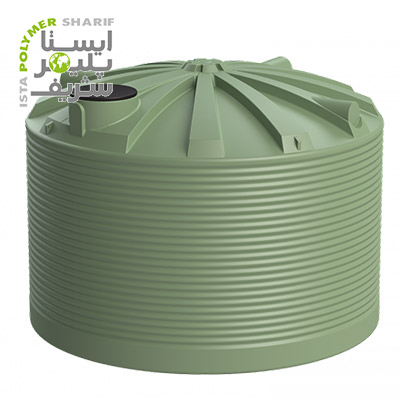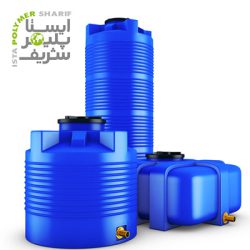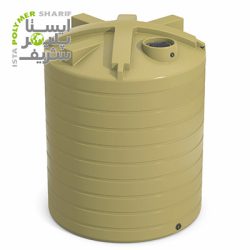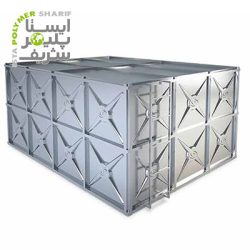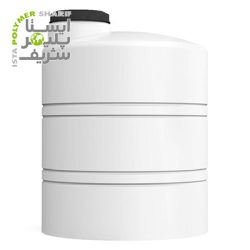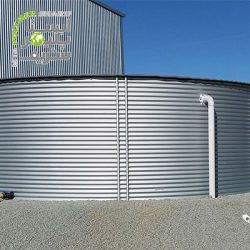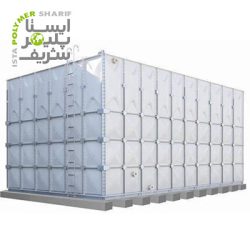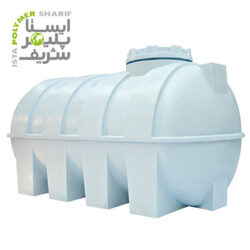Tanks refer to containers or tanks made of plastic, steel, or aluminum that are used for storing various fluids. Tanks can be produced in various designs and shapes. Each type of tank is manufactured for storing specific liquids under special conditions. In this article, we will try to familiarize you with different types of tanks, their features, and the applications of each type. So, if you want to learn more about this subject, stay with us until the end of this article.
What is a tank?
A tank refers to storage containers for fluids and liquids that are produced in various shapes. When purchasing a storage container, you must first determine what it will be used for, as each type of tank is designed and manufactured for a specific application. Tanks can be made from various materials such as steel, chemical polymers like polyethylene, polypropylene, stainless steel, aluminum, and more. In the past, steel tanks were predominantly used. Over time, the use of these types of tanks decreased because steel tanks are relatively expensive and heavy, making them less convenient to transport and handle.
What components make up a tank?
In general, tanks consist of several different parts. The shell or the main body of the tank is produced in various shapes such as spherical, cylindrical, and so on. The heads or caps are placed on both ends of the shell and come in various shapes like oval, flat, or conical. Another main component of tanks is the manhole, which is designed and installed for people to enter relatively large tanks for cleaning purposes.
Inlet and outlet pipes are also parts of the tanks used for the inflow and outflow of liquids into and out of the tank. The vent is another essential component used in different types of tanks to release excess vapors and gases from the top of the container. The vent also helps control the air pressure inside the tanks.
The drain pipe is another part of a storage container, located at the end of the pipe to discharge fluids or waste materials. The ladder is an auxiliary tool in tanks, welded to provide access to the top part. In fact, the ladder is used to reach the manhole. Supports are used to hold the container in place at the installation site or on the ground. The mixer is another component of tanks, connected to the top of the head by a shaft and equipped with one or more propellers.
In addition to the aforementioned components, each tank is equipped with special equipment tailored to its specific application. This equipment includes the following:
Thermometer, rock wool insulation, steam ring, pressure gauge, and egg crate panel
Types of Tanks
As mentioned above, tanks are categorized into various types based on their design, material, usage, and features. Below are some examples of industrial tanks and the application of different types of tanks in the industry.
Industrial Fuel Tanks
Each type of tank in the industry serves a specific purpose. One of the most important types of industrial tanks is the special fuel storage tanks. These tanks are used for storing gas, oil, and other fuels. They can be produced in various sizes and shapes. Industrial tanks can be used horizontally, vertically, or underground and are made from concrete, stone, fiberglass, plastic, or steel. Fuel tanks are also available in above-ground and underground types, with above-ground tanks being more cost-effective due to the lack of high maintenance and deep excavation costs. Underground tanks are mostly used for storing hazardous, toxic, or explosive materials. When burying these tanks, about 20% of the tank is buried underground.
Special Chemical Storage Tanks
Another type of tank used in the industry is the special chemical storage tank. These tanks are used for storing chemical liquid fertilizers, petroleum products, propane, and other chemicals. These tanks are used for mixing, permanent storage of materials, or transportation of chemical products or raw materials. They have high resistance to acids and bases and are rarely corroded or oxidized. Chemical tanks are usually made from steel, fiberglass, or polyethylene.
Industrial Hot Water Tanks
Some industries always require hot water, which makes the use of special hot water storage tanks essential. These tanks are fully insulated to prevent heat loss. Some of these tanks can store hot water for several days. Sometimes, these tanks are equipped with a gas burner, oil burner, or electric heater to provide a constant supply of hot water. Household wall-mounted water heaters are a type of these tanks. These tanks are mostly made of fiberglass.
Industrial Plastic Tanks
Plastic tanks are another commonly used type of tank in the industry, mainly for storing water used in various industrial processes. These tanks are usually made from polyethylene or polypropylene polymers, which are very lightweight due to their low density. If these tanks are used for storing drinking water, they must be certified by the Ministry of Health. The use of plastic tanks in various industries, including agriculture, horticulture, and livestock farming, is also very common.
Oil Storage Tanks with Floating, Fixed, or Closed Roofs
There are other types of tanks that include a floating roof. These tanks are mainly used for storing large volumes of oil. The floating roof in these oil storage tanks allows the oil level to rise and fall. As a result, this process prevents vapor buildup on the roof and top of the tank. Tanks with floating roofs are mostly made from stainless steel, reinforced concrete, and in some cases, chemical polymers like polyethylene and polypropylene.
There are also examples of oil storage tanks with fixed and closed roofs. Tanks with fixed roofs are used for storing smaller volumes of oil. Closed tanks are used to prevent leaks and contamination caused by oil.
Types of Tanks by Shape and Design
If we categorize tanks by shape and design, they include various types such as horizontal, vertical, book-shaped, cubic, cylindrical, and more. The use of each tank depends on the installation location and the characteristics of the site. For example, if the tank is to be installed in narrow corridors, book-shaped tanks are preferable. In low-height spaces, horizontal tanks are the best option. Vertical tanks are very suitable for places without height restrictions. Cubic tanks are designed for unused and multi-faceted spaces.
Conclusion
Tanks are equipment used for storing various liquids and fluids. Tanks or containers come in various types, each designed and manufactured for a specific application. The application of each type of tank is determined by its features. In essence, each type of tank is used in a specific industry based on its material, design, and the liquid it stores. In this article, we have introduced tanks, their features, and applications as much as possible. I hope the provided information has been useful and valuable for you.

